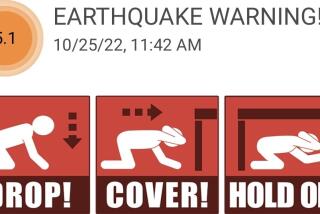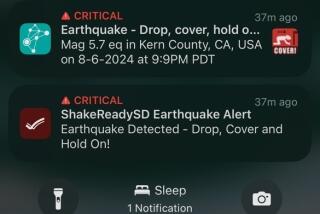Hydrogen Gas May Be Earthquake Warning
HONOLULU — A new method of predicting earthquakes and volcano eruptions days before they occur is being developed by geologists in the United States and Japan. They say that it could soon become widely used throughout the world to warn of impending disaster.
The method exploits the observation that, in the days before a cataclysm, wisps of hydrogen gas seep from the soil along quake faults and from fume vents in volcanic regions. The gas is believed to form in chemical reactions that occur when rocks deep within the earth undergo stresses that build before a tremor or eruption.
Hydrogen Detectors
Automatic hydrogen detectors have been placed along such major earthquake zones as California’s San Andreas and Calaveras faults and around volcanoes in Hawaii and at Mt. St. Helens in Washington. Information from the detectors is transmitted continuously, via satellite, to analysts at the U.S. Geological Survey’s volcano observatory in Vancouver, Wash.
“We are most encouraged with what we have found so far,” Kenneth McGee, a geologist at the observatory, said. “The correlation between hydrogen emissions and subsequent events looks good enough that I think we’re well on our way to developing a technique that will become widely established in years to come.”
McGee and other researchers doing similar work in Japan presented their findings to the International Chemical Congress of Pacific Basin Societies here last month. The meeting was attended by more than 3,700 scientists from 38 countries bordering the Pacific Ocean.
The fringe of the Pacific constitutes one of the world’s most geologically active zones because the piece of the earth’s crust that constitutes the ocean floor, the so-called Pacific plate, is continually grinding against continental plates.
Movement Episodic
Although the forces driving the Pacific plate--ponderous currents in the semi-molten rock below--act continuously, the plate’s movement is episodic. Geologists believe that, as two plates grind against each other, strain builds in the surface rock until the forces are great enough to overcome local resistance. Then one plate suddenly lurches past the other.
For all the damage this lurching can cause above ground, it is a relief of accumulated strain below. Emission of hydrogen is thought to be a byproduct of microscopic cracks that develop in the rock as the strain begins to approach the rock’s breaking point.
“We think that as this microfracturing permeates the rock, it allows water to seep in and react with the newly exposed rock surface, producing hydrogen gas as a byproduct,” said Motoaki Sato of the geological survey’s headquarters in Reston, Va.
Sato, who began developing this method in Hawaii in the early 1970s, invented the hydrogen detector by adapting the concept of the fuel cell. This is a device that combines molecules of hydrogen and oxygen into water, with electricity a byproduct. Fuel cells have been used in manned spacecraft as sources of water and power.
The hydrogen detector is essentially a fuel cell with no built-in source of hydrogen fuel. Should hydrogen waft into its reaction chamber, the electricity generated becomes the signal that rocks far below are beginning to crack. Because hydrogen gas is almost non-existent in ordinary air, especially at ground level, where the detectors are placed, the devices can be sensitive to slight amounts rising from the soil.
The scientists said earthquakes or eruptions usually followed within days of the detectors’ registering sudden surges in the amount of hydrogen. The hydrogen seems to come in pulses lasting several hours. Usually the detectors send their signal long before the motion is great enough to register on a seismometer.
Sato and McGee said that before the method is used to issue public forecasts, they would like to accumulate more data so they can see how the timing and amounts of hydrogen relate to the size and timing of the earthquake or eruption.
Even with this link, they said, hydrogen emissions alone would not be used to make a prediction. Other indicators, such as seismic vibrations from magma moving below the surface and the swelling or tilting of land surfaces, still would be used.
“Predicting these things is a very tricky business,” Sato said. “Look how much trouble meteorologists have. And what they’re studying is mostly above ground.”
More to Read
Sign up for Essential California
The most important California stories and recommendations in your inbox every morning.
You may occasionally receive promotional content from the Los Angeles Times.










